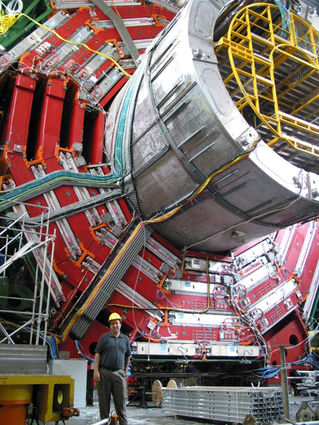Large Hadron Collidor launches new physics era
 (Download Image)
Lab physicist David Lange dwarfed by the 20,000-ton Compact Muon Solenoid (CMS) detector at the Large Hadron Collider, the world’s most powerful accelerator.
(Download Image)
Lab physicist David Lange dwarfed by the 20,000-ton Compact Muon Solenoid (CMS) detector at the Large Hadron Collider, the world’s most powerful accelerator.
Laboratory researchers were among the thousands of scientists around the world who celebrated Tuesday's much-anticipated start of the Large Hadron Collidor research program at CERN near Geneva, Switzerland. The first particles collided at the record energy of 7 trillion electron volts (TeV) in the accelerator's 17-mile magnetic ring, the highest energy yet achieved in a particle accelerator.
"This is the beginning of a new age of experiments," said Doug Wright, LLNL physicist and Lab team leader for the Large Hadron Collidor's (LHC) Compact Muon Solenoid (CMS) detector experiment. "Data from the LHC will lead us to a completely new understanding of our universe."
Tuesday's proton collisions were recorded by the LHC experiments' particle detectors, known by their acronyms: ATLAS, CMS, ALICE and LHCb. While the LHC accelerator brings the protons up to their maximum energy and steers them around the 17-mile ring into collision, the experiments use massive particle detectors to record and analyze the collision debris.
The CMS experiment, which the Laboratory helped complete, is a hulking 20,000-ton detector that is searching for the elusive "Higgs boson" and evidence of the nature of dark matter. Along with Wright, Lab scientists contributing to CMS include David Lange and Jeff Gronberg. Lange with postdoc Bryan Dahmes, led an LDRD to develop trigger and event data processing for the detector. Lange is now responsible for the CMS data reconstruction software. (See the Sept. 12, 2008 article.)
Gronberg, who led a Lab-wide Laboratory Directed Research and Development with postdoc Jonathan Hollar, developed a novel physics analysis that showed that CMS can detect a theoretically clean conventional physics signal from muon pairs, which will result in one of the early CMS publications. This channel also can be used to discover new particles if combined with signals from detectors placed downstream of the main experiment. Gronberg now leads LLNL's participation in an upgrade to add these downstream detectors.
Lab physicist Ron Soltz leads the LLNL effort, which includes postdoc Andrew Glenn, for the A Large Ion Collider Experiment (ALICE), a heavy ion physics detector looking for a form of matter called quark-gluon plasma believed to have existed shortly after the big bang. Soltz succeeded in securing DOE Office of Nuclear Physics support to create a new computing cluster at LLNL that will help fulfill the DOE commitment to provide computing for ALICE.
More than 1,700 scientists, engineers, students and technicians from 89 American universities, seven Department of Energy (DOE) national laboratories and one supercomputing center helped design, build and operate the LHC accelerator and its four massive particle detectors. American participation is supported by the DOE's Office of Science and the National Science Foundation (NSF).
Now, the real work begins for the LHC teams. Over the next 18 to 24 months, the LHC accelerator will deliver enough collisions at 7 TeV to enable significant advances in a number of research areas. As data begins to pour from their detectors, more than 8,000 LHC scientists around the world will sift through the flood in search of the tiny signals that could indicate discovery.
Much like the particles whizzing through the LHC magnetic tunnel at near the speed of light, Wright's career in particle physics has come full circle, though more slowly. He began his career at LLNL in 1993 working as a postdoc on the Superconducting Super Collider (SSC), which would have been the world's most powerful particle accelerator had it not been scuttled later that year. Wright subsequently went on to work on the BaBar collaboration at the Stanford Linear Accelerator Center (SLAC). The Babar detector was built to study B mesons particles produced by SLAC-LBNL-LLNL PEP-II accelerator.
"When I started in Livermore, the Lab had two postdocs working on the SSC: Torre Wenaus and me. Torre eventually left and is at Brookhaven National Laboratory, where he is working on the ATLAS detector experiment. I am still here and I am on CMS, a competing experiment," Wright said. "So now, 17 years later, we have a chance to do the physics we had dreamed of back then."




